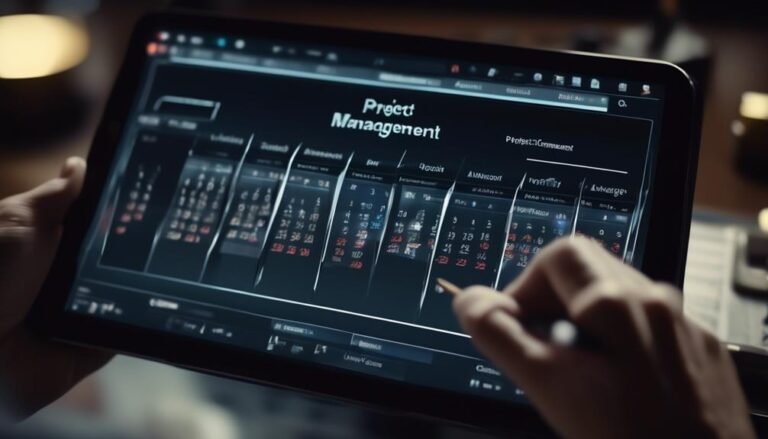How to Overcome Barriers of Communication?
Imagine you're at a crowded party, trying to have a conversation with someone across the room. As you speak, the noise and distractions make it difficult for your words to reach their intended target. You find yourself having to repeat your message multiple times, resulting in frustration and miscommunication.
Just like this scenario, barriers of communication can hinder our ability to effectively convey our thoughts and understand others. But fear not, for there are proven strategies that can help you overcome these obstacles and pave the way for clearer, more meaningful communication.
So, how can you break down these barriers and ensure your message is received loud and clear? Let's explore together.
Key Takeaways
- Language barriers can hinder understanding, so it's important to use simple and clear language, avoid jargon or slang, and provide translations or interpreters when necessary.
- Improving active listening skills is vital for effective communication. This includes using active communication techniques, maintaining eye contact, and paraphrasing or summarizing the speaker's message.
- Nonverbal communication, such as body posture, facial expressions, and hand gestures, plays a crucial role in conveying messages effectively. Maintaining an open and relaxed posture, using appropriate facial expressions, and making purposeful hand gestures can enhance communication.
- Cultivating empathy and understanding is crucial for effective communication. This involves practicing perspective taking, actively listening and validating others' feelings, and suspending judgment and assumptions.
Identifying Communication Barriers
Identifying communication barriers is crucial for effective and efficient communication. Overcoming language barriers and addressing cultural differences are essential in improving overall communication.
Language barriers can hinder understanding and create confusion. To overcome this barrier, it's important to use simple and clear language, avoid jargon or slang, and provide translations or interpreters when necessary.
Additionally, addressing cultural differences is vital in fostering effective communication. Cultural norms, values, and beliefs can greatly impact communication styles and expectations. Taking the time to understand and respect different cultural practices can help bridge the gap and promote better communication.
Improving Active Listening Skills
To enhance your communication skills further, it is crucial to focus on improving your active listening abilities. Active listening is a vital component of effective communication and involves fully engaging with the speaker and understanding their message. By actively listening, you can improve your listening comprehension and strengthen your overall communication skills.
One way to improve your active listening skills is by employing active communication techniques. These techniques involve demonstrating your attentiveness and interest in the conversation. This can be done by maintaining eye contact, nodding or using other non-verbal cues to show that you are engaged. Additionally, paraphrasing or summarizing the speaker's message can help ensure that you have understood correctly and fosters a deeper connection.
By actively listening and employing these techniques, you can improve your communication skills and build stronger relationships with others. Take the time to practice active listening and watch as your comprehension and communication abilities soar.
| Active Listening Techniques | Benefits |
|---|---|
| Maintaining eye contact | Shows interest and attentiveness |
| Using non-verbal cues | Demonstrates engagement and understanding |
| Paraphrasing and summarizing | Ensures accurate understanding of the message |
Enhancing Nonverbal Communication
Enhance your communication skills by mastering the art of nonverbal cues. Nonverbal cues, such as body language, play a crucial role in conveying your message effectively and building strong connections with others.
They can enhance the impact of your verbal communication and help you establish trust and rapport. Pay attention to your body posture, facial expressions, hand gestures, and eye contact. Maintain an open and relaxed posture, use appropriate facial expressions to convey emotions, and make purposeful hand gestures to emphasize key points.
Additionally, maintain good eye contact to show interest and attentiveness. By enhancing your nonverbal communication skills, you can become a more confident and persuasive communicator, making your message more impactful and fostering better understanding and connection with others.
Cultivating Empathy and Understanding
Developing empathy and understanding is crucial for effective communication and building strong connections with others. When you cultivate empathy, you are able to understand and share the feelings of others. This allows you to connect on a deeper level and build rapport. One way to cultivate empathy is by practicing perspective taking. By putting yourself in someone else's shoes and trying to see things from their point of view, you can better understand their thoughts, feelings, and motivations. This helps to break down barriers and promotes open and honest communication. Check out the table below for some practical tips on how to cultivate empathy and understanding in your interactions with others:
| Tips for Cultivating Empathy and Understanding |
|---|
| Listen actively and attentively |
| Validate and acknowledge others' feelings |
| Practice non-judgment and suspend assumptions |
| Ask open-ended questions to encourage dialogue |
| Show empathy through body language and gestures |
Utilizing Effective Communication Techniques
In order to effectively communicate, it's important to utilize a variety of techniques that promote clear and concise exchange of information. By improving clarity in your communication, you ensure that your message is easily understood by the recipient.
This can be achieved by using simple and straightforward language, avoiding jargon or technical terms that may confuse others. Additionally, employing active listening skills, such as paraphrasing and asking clarifying questions, can help to ensure that both parties are on the same page.
Fostering rapport is another crucial technique in effective communication. Building a positive relationship with the person you're communicating with can help to create a safe and open environment for sharing ideas and opinions. This can be done by showing empathy, being respectful, and maintaining a non-judgmental attitude.
Conclusion
Overcoming communication barriers requires a proactive approach. By identifying and addressing these obstacles, improving active listening skills, enhancing nonverbal communication, cultivating empathy and understanding, and utilizing effective communication techniques, you can create a more inclusive and effective communication environment.
Remember, communication is the lifeblood of relationships and understanding, so don't shy away from embracing these strategies to foster meaningful connections.







